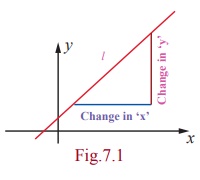Meaning of Derivatives | Mathematics - Derivative as slope | 12th Maths : UNIT 7 : Applications of Differential Calculus
Chapter: 12th Maths : UNIT 7 : Applications of Differential Calculus
Derivative as slope
Derivative as
slope
Slope or Gradient of a line: Let l be any given non vertical line as in the Fig. 7.1. Taking a finite horizontal line segment of any length
with the starting point in the given line l
and the vertical line segment starting from the end of the horizontal line to
touch the given line. It can be observed that the ratio of the vertical length
to the horizontal length is always a constant. This ratio is called the slope
of the line l and it is denoted as m .

The slope can be used as a measure to determine the increasing or decreasing nature of a line. The line is said to be increasing or decreasing according as m > 0 or m < 0 respectively. When m = 0 , the value of y does not change. Recall that y = mx + c represents a straight line in the XY plane where m denotes the slope of the line.
Slope or Gradient of a curve: Let y = f ( x)
be a given curve. The slope of the line joining the two distinct points ( x , f
( x)) and the point ( x + h,
f ( x + h)) is

Taking
the limit as h ŌåÆ
0 , we get

which is
the slope of the curve at the point ( x
, y) or ( x , f ( x)) .
Remark
If ╬Ė is the angle made by the tangent to
the curve y =
f ( x) at the Point ( x , y) , then
the slope of the curve at ( x , y) is
fŌĆÖ(x) = tan ╬Ė , where ╬Ė is measured in the anti-clockwise direction from the X -axis. Note that, fŌĆÖ(x)
is also denoted by dy/dx and also
called instantaneous
rate of change. The average rate of change in an interval is calculated
using Newton quotient.
Example 7.1
For the
function f (x) = x2
, x Ōłł[0, 2] compute the average rate of
changes in the subintervals [0, 0.5],[0.5,1],[1,1.5],[1.5, 2] and the
instantaneous rate of changes at the points x
=
0.5,1,1.5, 2 .
Solution
The
average rate of change in an interval [a,
b] is [ f (b) ŌłÆ
f (a) ] / [b ŌĆō a] whereas, the instantaneous rate of change at a point x is f
ŌĆ▓(
x) for the given function. They are
respectively, b +
a and 2x .
Rate of changes

Related Topics